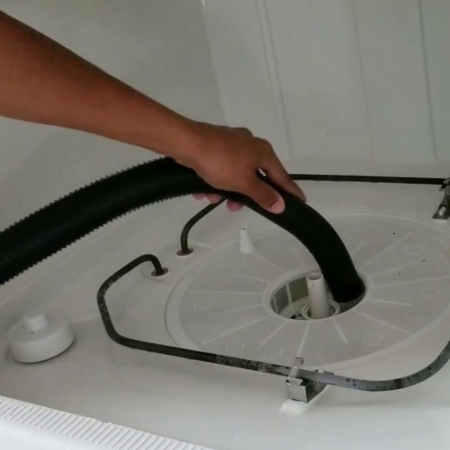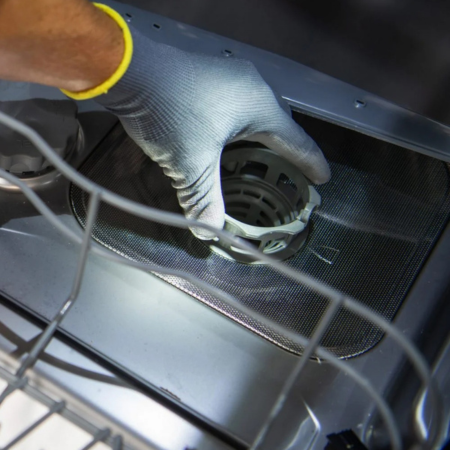If you own a GE dishwasher, you may encounter a common issue where it refuses to drain.
This problem can be frustrating and might leave you bewildered, especially after a long day when you only wanted a helping hand to clean up after dinner.
This article aims to help you understand the possible causes behind your GE dishwasher not draining.
We will guide you through simple troubleshooting steps to help resolve the issue without always having to call a professional.
Remember, most home appliance issues can be tackled head-on with patience and the right guidance.
Key Points
- Clogged Drain Hose: The most common cause of a dishwasher not draining is a clog in the drain hose. Food debris or grease might have built up over time and obstructed the water flow.
- Faulty Drain Pump: A defective drain pump can also prevent the dishwasher from draining. The pump uses an impeller to force water into the drain hose.
- Blocked Garbage Disposal: If you’ve recently installed a garbage disposal, ensure the knockout plug has been removed.
- Non-Functional High-Drain Loop: GE dishwashers use a ‘high-drain loop’ setup. If this isn’t functioning properly, it might cause the dishwasher not to drain.
5 Reasons Why Is GE Dishwasher Not Draining
Before we delve into the specifics, let’s understand that a dishwasher not draining can be due to several reasons. Here are the five most common ones for your GE dishwasher:
1. Clogged Drain Hose
A clogged drain hose is one of the most common reasons for a GE dishwasher not draining. This can occur when food particles or other debris accumulate in the hose over time.
Do you notice water standing at your dishwasher’s bottom after a cycle? This could be a telltale sign of a blocked drain hose.
The function of the drain hose is to expel used water from the dishwasher. If it gets blocked, draining becomes difficult, leaving you with a messy situation.
Fixing this issue doesn’t always require professional help. First, check the drain hose for visible clogs and remove them. If the problem persists, it might mean a deeper blockage.
In such a case, consider detaching the hose for a more thorough cleaning. Always remember to turn off and unplug your dishwasher before attempting any fixes. Safety first!
Solution
The solution involves a simple process. Start by unplugging the dishwasher from the power source. Next, locate the drain hose at the base of the machine.
Detach it carefully. Use a straightened wire hanger or similar tool to remove any blockages gently.
Rinse the hose thoroughly under warm water. After cleaning, reattach the hose securely. Finally, plug in and test your dishwasher.
If water drains correctly, the problem’s solved. However, if it persists, consider getting help from a professional.
2. Faulty Drain Pump
The drain pump in your GE dishwasher plays a key role in the draining process. It operates to force water through the drain hose. It may fail to pump out the water when it malfunctions, leading to your dishwasher not draining.
Common signs of a faulty drain pump include strange noises during the cycle or a silent dishwasher when it should be draining.

Fixing a faulty drain pump can be tricky. Sometimes, it might just be a loose connection or a blocked impeller. Disconnect and inspect the pump for any visible issues.
However, if the pump is severely damaged, you might need to replace it.
Remember, always disconnect your dishwasher from power before attempting any fixes. If you’re unsure, it’s best to call a professional.
Solution
First, unplug your dishwasher. Find the drain pump and disconnect it.
Look carefully for any visible problems. A blockage or loose connection may be the culprit. If so, clear the blockage or secure the connection.
If the damage is severe, consider a replacement. Always remember safety is paramount, so disconnect the power before attempting any fixes.
If in doubt, it’s better to call a professional. After fixing, test the dishwasher. If it drains properly, your problem is solved.
3. Blocked Garbage Disposer
If your GE dishwasher has a new garbage disposer installed, it might be causing drainage problems.
The disposer has a drain plug that must be removed before connecting the dishwasher. If overlooked, it can block the drain path.
An easy sign of this issue is if the problem started after a new garbage disposer installation.
Reach into the disposer with pliers and remove the plastic plug to fix this. Be sure to disconnect the disposer from power first for safety.
For existing disposals, a clog may occur over time. Run the disposer to clear any potential blockages.
If this doesn’t solve the problem, you may need to inspect the drain hose connection on the disposer for clogs.
Ensure that the power is disconnected before any inspections. Call a professional if unsure.
Solution
The issue could be with your garbage disposer. Did you recently install one? New disposers have a drain plug.
Forget to remove it, and it could block your dishwasher’s drain. Here is a quick fix: Disconnect the disposer from power.
Reach into the disposer using pliers. Remove the plastic plug. If your disposer isn’t new, run it. It could clear any blockages.
Remember, safety first. Always disconnect from power before inspections. For any doubts, call a professional.
4. Broken Drain Valve
A broken drain valve can cause your dishwasher not to drain. This valve opens to let the dirty water out during the draining cycle.
If it’s broken, it won’t open, and water will remain in the dishwasher.
You’ll notice this issue if your dishwasher is silent during what should be the drain cycle. Another sign is water left in the bottom after a full cycle.
To diagnose, first disconnect the power for safety. Then, locate the drain valve, typically near the motor. Check for any mechanical issues.
Common problems include a broken solenoid or a stuck or broken lever. You can try to move the lever manually. If it doesn’t move or if you notice any severe damage, you might need a new valve.
Fixing a drain valve generally requires a professional, as it involves taking apart significant portions of the dishwasher.
Solution
If you suspect a broken drain valve, safety comes first. Unplug your dishwasher. Find the drain valve near the motor. Check for mechanical issues.
Signs include a stuck lever or a broken solenoid. Try moving the lever manually. If it’s immovable or visibly damaged, it’s time for a new valve.
Replacing a valve often needs a professional. It involves disassembling large parts of the dishwasher.
5. Incorrectly Installed Drain Hose
The dishwasher drain hose connects the dishwasher to the air gap or garbage disposer. An incorrect installation could lead to drainage problems.
Firstly, the hose might be kinked or pinched. This can restrict water flow, causing it not to drain.
The second issue could be the high loop. The drain hose should be looped high up to prevent sink water from flowing into the dishwasher.

Lastly, check if the hose is running downhill. It should be rising from the dishwasher before running to the drain.
Diagnose by inspecting the hose. Look for kinks and ensure it’s looped high and runs downhill. If it doesn’t, you need to adjust or replace it. Always disconnect power before inspections and repairs. If unsure, call a professional.
Solution
Examine your dishwasher’s drain hose. It links the dishwasher to the air gap or garbage disposer. Check for kinks.
A pinched hose restricts water flow. Ensure the hose loops are high. This prevents sink water from entering the dishwasher.
The hose should rise from the dishwasher before draining. Look for these signs during the inspection. If necessary, adjust or replace the hose.
Always unplug before inspecting or repairing. Contact a professional if you’re uncertain.
Frequently Asked Questions
1. Why is my GE dishwasher not draining?
Several issues could be causing your GE dishwasher not to drain. It could be due to a clogged drain, a malfunctioning drain pump, or a blocked drain hose. Running a cleaning cycle or manually unclogging the drain may resolve the issue, but if not, you may need to call a professional.
2. How can I unclog the drain of my GE dishwasher?
You can unclog the drain by removing and cleaning the dishwasher filter, which is usually located at the bottom of your dishwasher. If the clog is stubborn, you might require a commercially available drain cleaner or a plumber’s assistance.
3. Can a malfunctioning drain pump cause my GE dishwasher not to drain?
Yes, a faulty drain pump can prevent your GE dishwasher from draining. The drain pump pushes water through the drain hose. If it’s malfunctioning, the water can’t be pushed out, resulting in standing water. It’s advisable to seek professional help in such cases.
4. What should I do if my GE dishwasher’s drain hose is blocked?
If the drain hose of your GE dishwasher is blocked, you can try to manually remove the obstruction or clean the hose with a long-handled brush. If these solutions do not work, it may be necessary to replace the drain hose, and professional aid might be required.
Conclusion
Dishwasher issues can be stressful. They’re mostly due to faulty valves or incorrectly installed drain hoses.
Before resorting to a professional service, inspect for visible damages.
Check the valve and examine the drain hose.
Look for kinks, incorrect loops, or downhill runs. Adjust or replace as needed. Remember to disconnect the power before inspection.
If in doubt, seek professional help. Simple checks can lead to easy fixes. Stay informed and proactive.
- Can You Scrap A Microwave And Why You Should? - May 13, 2024
- Can You Put Metal In A Convection Microwave: 10 Major Risks - May 12, 2024
- Can You Use A Microwave Without The Glass: 10 Benefits - May 11, 2024

